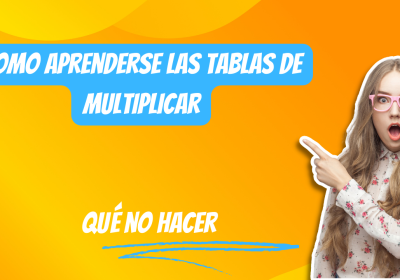Many times, the worst things are done with the best intentions. I have never known a student who has a multiplication table poster in their room and memorizes it. Also, there are notebooks with all multiplication tables on the back cover that do more harm than good. If you want your child never to learn the tables, buy them a poster and stick it on the wall of their room, or get a notebook that contains multiplication tables on the back.
What is the best age to learn multiplication tables?
Learning to multiply is crucial for a person’s development in mathematics. A child with gaps in multiplication will be a student who always struggles with math. So, if you have a child having trouble with multiplication, you still have time to address this situation. Age is key for a person to learn multiplication. The younger they are, the easier it will be.
It is recommended that a child starts learning multiplication once they have mastered addition and subtraction. Therefore, starting at seven or eight is the best time to learn multiplication. In my experience as a math teacher, I could say that the best age to learn multiplication is between eight and twelve years old. We always leave room for exceptional children who handle numbers very well at an early age and also for people (adolescents and adults) who want to achieve their goals regardless of age. When you truly want something, your only opponent is the person in the mirror.
What to do if you already bought notebooks or posters with multiplication tables?
It is very disheartening for me as a teacher to see a parent acquire one of these famous posters or notebooks with all multiplication tables, thinking that their child will have educational support to learn all the tables. Perhaps, you, as the person responsible for your child’s education who has already bought these supposed «multiplication aids,» may be wondering:
How is it possible that they never learn the tables, when they are given quick access and have the chance to see multiplication tables every day?
You would think that by constantly seeing multiplication tables in their notebook or poster on the wall, your child would reach a point of memorization. But, unfortunately, this is not what happens in most cases. Most students graduate from high school without knowing the tables because their brains were in a comfort zone regarding multiplication.
Instead of learning the tables by seeing them in their room, the result is quite the opposite: the child’s brain gets comfortable and learns to use the poster or notebook as a quick option to avoid the effort of calculating the tables. In contrast, if every time the student has to do a multiplication table, they have to go through a process of addition or subtraction, memorization becomes easier. The effort increases the memorization capacity.
The human brain always seeks comfort and tries to make the least possible effort. It is much like our body, which loves to be seated or lying down. It’s our human nature; our brain is created to save energy, so for anything that seems laborious, the brain will do its best to avoid the effort and seek rest. So, have the child calculate the tables with pencil and paper, and get rid of those notebooks or posters.
Why do many people do not like mathematics?
Mathematics is an example of how comfortable the human brain is. In a classroom of twenty students, perhaps only four or five students like mathematics. It is the most logical subject of all. To pass an evaluation, we cannot disguise or alter the answer. In contrast, other subjects can be passed by simply memorizing concepts or definitions.
How to make my child like mathematics?
It is more frustrating for a child not to know how to multiply. Addition and subtraction require less effort from our brains, and it takes less time to learn to add or subtract. In contrast, multiplication requires more time, along with the requirement that, to streamline the multiplication process, the student needs to be able to add and subtract easily.
The first significant obstacle a student faces after learning to add and subtract is dealing with multiplication. This is where most gaps come in, as after multiplication, a myriad of topics requiring multiplication knowledge follows.
Do not miss the opportunity; if your child is having difficulty with multiplication, you still have time. You can make your child like mathematics by helping them with multiplication. There are camps, intensive courses, private teachers, worksheets on websites, and many other educational resources. The key is repetition and consistency.
How to memorize multiplication tables?
Although many methods with mathematical patterns facilitate the calculation of multiplication tables, the ultimate goal is for a student to memorize and never forget the tables from 1 to 10. Some countries focus on tables from 1 to 12. Profesami always teaches multiplication tables up to twelve.
The goal of memorizing the tables is that through repetition, a point of memorization is reached where the student does not need to use any method or strategy. It is like learning a language; words do not change their meaning, and through constant practice, people memorize their meaning.
If a child finds it challenging to calculate multiplication tables, it is important to let them find each answer through addition. Remind them that multiplying is synonymous with adding groups that have the same number of elements. Never give them the answer, even if the task takes two hours. Also, the student can use multiples through addition as a tool for multiplication. That is, if they need to calculate the 8-table, they should add eight by eight to find all the multiples corresponding to the 8-table.
Final Recommendation
Profe Sami never recommends these types of easily accessible resources for multiplication tables. No posters on the wall, notebooks, or any tool that allows the child to visualize the tables effortlessly. Instead, download worksheets and practice the tables until complete mastery is achieved.
Multiplying is easy; it only requires practice and a bit of patience. An average child can master the tables in one or two months with discipline. This requires the collaboration of parents or hiring a private tutor who specifically focuses on multiplication tables.
In the same vein, never allow calculators at home until the child is in advanced grades that require the mandatory use of a calculator. Understand, do not let your children use calculators until they are twelve or thirteen years old, depending on the needs of the grade level.
Where to seek help for my child to learn multiplication?
If you need help, as a parent or guardian, you should hire an expert to help your child master the tables. You can also enroll in programs or online courses like the one offered by Profe Sami on their YouTube channel or download the guide to multiplication: Multiply in 4 Weeks, available on Amazon. Multiplying is a matter of repetition and consistency. Everyone can learn and memorize multiplication tables forever.


